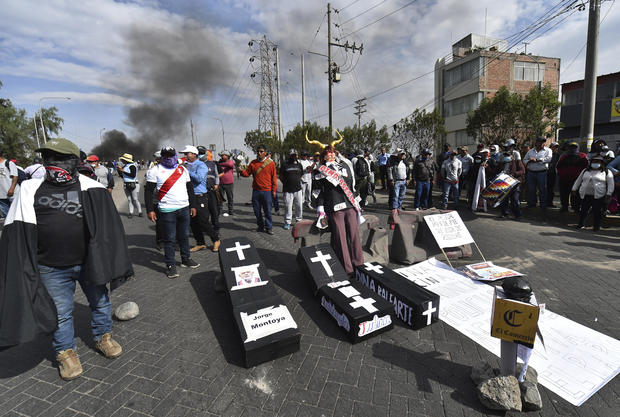Police fired tear gas to try to subdue thousands of protesters who poured into the Peruvian capital Thursday, many from remote Andean regions, calling for the ouster of President Dina Boluarte and the return to power of her predecessor, whose removal last month launched deadly unrest and cast the nation into political chaos.
The demonstrators gathered in Lima’s historic downtown scuffled with security forces who barred them from reaching key government buildings, including Congress, as well as business and residential districts of the capital.
Besides Boluarte’s resignation, the supporters of former President Pedro Castillo were demanding the dissolution of Congress and immediate elections. Castillo, Peru’s first leader from a rural Andean background, was impeached after a failed attempt to dissolve Congress.

Jose Sotomayor / AP
For much of the day, the protests played out as a cat-and-mouse game, with demonstrators, some of whom threw rocks at law enforcement, trying to get through police lines and officers responding with volleys of tear gas that sent protesters fleeing, using rags dipped in vinegar to alleviate the sting to their eyes and skin.
“We’re surrounded,” said Sofia López, 42, as she sat on a bench outside the country’s Supreme Court. “We’ve tried going through numerous places and we end up going around in circles.”
As the sun set, fires smoldered in the streets of downtown Lima as protesters threw rocks at police officers who fired so much tear gas it was difficult to see.
“I’m feeling furious,” said Verónica Paucar, 56, coughing from the tear gas. “We’re going to return peacefully. Today we’re thousands, tomorrow we’ll be 3,000, 4,000, 5,000.”
There was visible frustration among protesters who had hoped to march into the Miraflores district, an emblematic neighborhood of the economic elite. In a Miraflores park, a large police presence separated the antigovernment protesters from a small group of demonstrators expressing support for law enforcement.
Late Thursday evening, firefighters were working to put out a large fire that broke out in a building near the protests in downtown Lima but its relationship to the demonstrations was not immediately clear.

Martin Mejia / AP
Until recently, the protests had been mainly in Peru’s southern Andes, with a total of 55 people killed in the unrest, mostly in clashes with security forces.
Anger at Boluarte was the common thread Thursday as protesters chanted calls for her resignation and street sellers hawked T-shirts saying, “Out, Dina Boluarte,” “Dina murderer, Peru repudiates you” and “New elections, let them all leave.”
“Our God says thou shalt not kill your neighbor. Dina Boluarte is killing, she’s making brothers fight,” Paulina Consac said as she carried a large Bible while marching in downtown Lima with more than 2,000 protesters from Cusco.
By early afternoon, protesters had turned key roads into large pedestrian areas in downtown Lima.
“We’re at a breaking point between dictatorship and democracy,” said Pedro Mamani, a student at the National University of San Marcos, where demonstrators who traveled for the protest were being housed.
The university was surrounded by police officers, who also deployed at key points of Lima’s historic downtown district — 11,800 officers in all, according to Victor Zanabria, the head of the Lima police force.
Protests were also held elsewhere and video posted on social media showed demonstrators trying to storm the airport in southern Arequipa, Peru’s second city. They were blocked by police and one person was killed in the ensuing clashes, Peru’s ombudsman said.

Martin Mejia / AP
The protests, which erupted last month, have marked the worst political violence in more than two decades and highlighted the deep divisions between the urban elite largely concentrated in Lima and the poor rural areas.
By bringing the protest to Lima, demonstrators hoped to give fresh weight to the movement that began when Boluarte was sworn into office on Dec. 7 to replace Castillo.
“When there are tragedies, bloodbaths outside the capital it doesn’t have the same political relevance in the public agenda than if it took place in the capital,” said Alonso Cárdenas, a public policy professor at the Antonio Ruiz de Montoya University in Lima.
The concentration of protesters in Lima also reflects how the capital has started to see more antigovernment demonstrations in recent days.
Boluarte has said she supports a plan to hold elections for president and Congress in 2024, two years before originally scheduled.
Activists have dubbed Thursday’s demonstration in Lima as the Cuatro Suyos March, a reference to the four cardinal points of the Inca empire. It’s also the name given to a massive 2000 mobilization, when thousands of Peruvians took to the streets against the autocratic government of Alberto Fujimori, who resigned months later.

Martin Mejia / AP
But there are key differences between those demonstrations and this week’s protests.
“In 2000, the people protested against a regime that was already consolidated in power,” Cardenas said. “In this case, they’re standing up to a government that has only been in power for a month and is incredibly fragile.”
The 2000 protests also had a centralized leadership and were led by political parties.
The latest protests have largely been grassroots efforts without a clear leadership, a dynamic that was clear Thursday as protesters often seemed lost and didn’t know where to head next as their path was continually blocked by law enforcement.
The protests have grown to such a degree that demonstrators are unlikely to be satisfied with Boluarte’s resignation and are now demanding more fundamental structural reform.
Protesters on Thursday said they would not be cowed.
“This isn’t ending today, it won’t end tomorrow, but only once we achieve our goals,” said 61-year-old David Lozada as he looked on at a line of police officers wearing helmets and carrying shields blocking protesters from leaving downtown Lima. “I don’t know what they’re thinking, do they want to spark a civil war?”
- In:
- Peru
- Protests
- Politics
